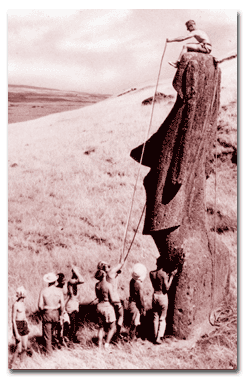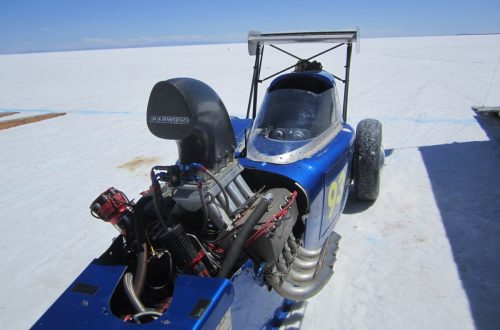
Thor Heyerdahl: Mr. Blue Sky
Norwegian explorer/scientist Thor Heyerdahl built an ancient-styled balsa wood raft Kon-Tiki and sailed it from Peru to Polynesia to prove that ancient South American Indians could have reached Polynesia. The voyage of his raft Kon-Tiki is just one of his many true-life adventures. Heyerdahl was also the first person to do an archaeological dig on Easter Island. He also sailed an ancient reed boat from Africa to the Americas.
On the Polyneisan island of Hivaoa, Heyerdahl had an experience that would change the course of his life. While exploring an inland valley, he happened upon two colossal stone statues. The stone men were ten feet tall and carved out of red stone. He was fascinated, wondering who had placed them there and how they had done it.
The natives knew little about the statues, claiming that they were already present when their ancestors arrived on the island and drove the previous inhabitants into the mountains. Someone on the island showed Heyerdahl a book containing pictures of similar statues. However, the statues in the book were in South America. Could there have been a connection between South America and Polynesia?
Heyerdahl then learned that folklore from all across Polynesia tells of a man named Tiki, who led fair-skinned, red-haired people to the islands from the direction of South America.
But this kind of migration was not possible. The leading authorities on Polynesian anthropology at the time said that the balsa rafts of the South American Indians were not seaworthy enough to travel away from the coast. They also agreed that the Indians did not have the navigating ability to make long ocean voyages. So, Polynesia could only have been populated from Asia.
Heyerdahl sat thinking about how the legend of Tiki contradicted the anthropological authorities on Polynesia. Then he looked at a small pineapple he was holding. Heyerdahl’s university studies on botany had taught him that the pineapple was a South American plant which could not have traveled thousands of miles across the ocean without the aid of man. It was well-documented that pineapples existed in the Marquesas long before the islands were visited by Europeans. (Other plants, like the papaya and the sweet potato were also South American plants that were cultivated there long before Europeans arrived.)
Heyerdahl wanted to study primitive peoples. “The unsolved mysteries of the South Seas had fascinated me. There must be a rational solution of them, and I had made my objective the identification of the legendary hero Tiki.”
He began researching the migration of the Polynesian people. He turned up several dozen theories on where the Polynesian people had come from, but all of them dismissed the possibility of a wave of migration from South America. It was widely held that the balsa rafts of the South American Indians would absorb water and sink after a short time at sea. All the experts were in agreement that only a hulled boat could make a journey from South America to Polynesia.
Then Heyerdahl uncovered another connection between South America and Polynesia. When Pizarro came to Peru in 1527, he found people among the Incas who were tall and light-skinned, with beards and fair, reddish hair.
They claimed to be descendants of the Viracochas, a race of sun-worshippers who had lived in the area before the Incas took over. The Viracochas were also supposed to have been the creators of large stone men and stepped pyramids found near Tiahuanaco in Peru. (These same types of structures appeared on Easter Island and the Polynesian islands closest to South America.)
The Viracochas had been attacked and massacred on an island in Lake Titicaca. The leader of their race escaped with some companions into the Pacific on balsa rafts. The leader’s name was Kon-Tici.
Heyerdahl was convinced that the chief-god Kon-Tici who left Peru was the same chief-god Tiki who came to Polynesia from the east and became a legend in Polynesian culture.
His research and theories were recorded in a manuscript called Polynesia and America; A Study of Prehistoric Relations. He took up residence in New York City and tried to get the scientific community in the U.S. to consider the paper, but no one was interested in reading theories that spanned several scientific disciplines. Scientists and scholars argued that he should either specialize in America or Polynesia, not both. One scientist told him, “You can’t treat ethnographic problems as a sort of detective mystery… The task of science is investigation pure and simple. Not to try to prove this or that.”
“It’s easier to get people interested in an expedition than in an unread manuscript,” he reasoned. He would put an end, once and for all, to the argument that Indians could not have reached Polynesia. He would do it by building a balsa raft just like the ones used by Indians in Peru and sailing it almost 5,000 miles to Polynesia.
The possibility of life-threatening circumstances on the expedition was real. Once the raft set sail, the crew really would be completely on their own until they reached land. Although they would have a radio on board, it would be of no use to them in an emergency. It would have been impossible for them to be rescued two or three thousand miles into the Pacific by either boat or airplane, assuming they could even be found. This was, after all, in the days before helicopters and global positioning systems.
The raft was ready to be christened on April 27th, 1947, scheduled to set sail the next day. The dock was thick with dignitaries, journalists and citizens. Weary of all the nay saying and public scrutiny, Heyerdahl later joked, “One thing was quite clear to all of us&emdash;that if the raft went to pieces outside the bay we would paddle to Polynesia, each of us on a log, rather than dare come back there again.”
The raft was christened Kon-Tiki and sported a sail painted with a likeness of the legendary chief-god, based on stone statues of him at Tiahuanaco. The raft was towed into the Humboldt current and set loose.
Excerpted from the feature article in the print edition of Barracuda #10. Get the whole story of Thor Heyerdahl’s adventures, plus a two-page interview with Heyerdahl himself!





